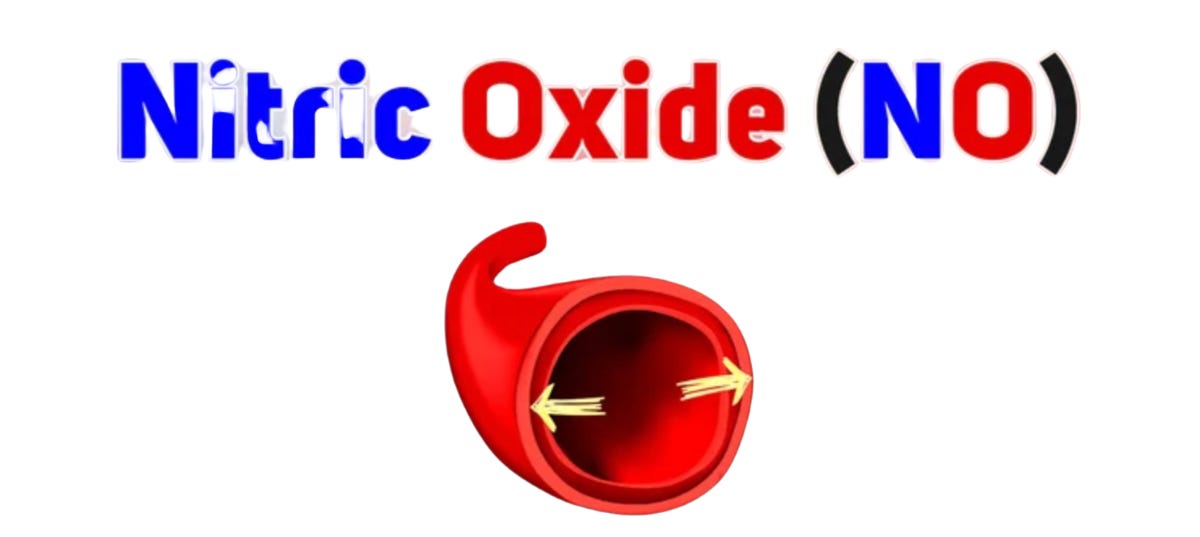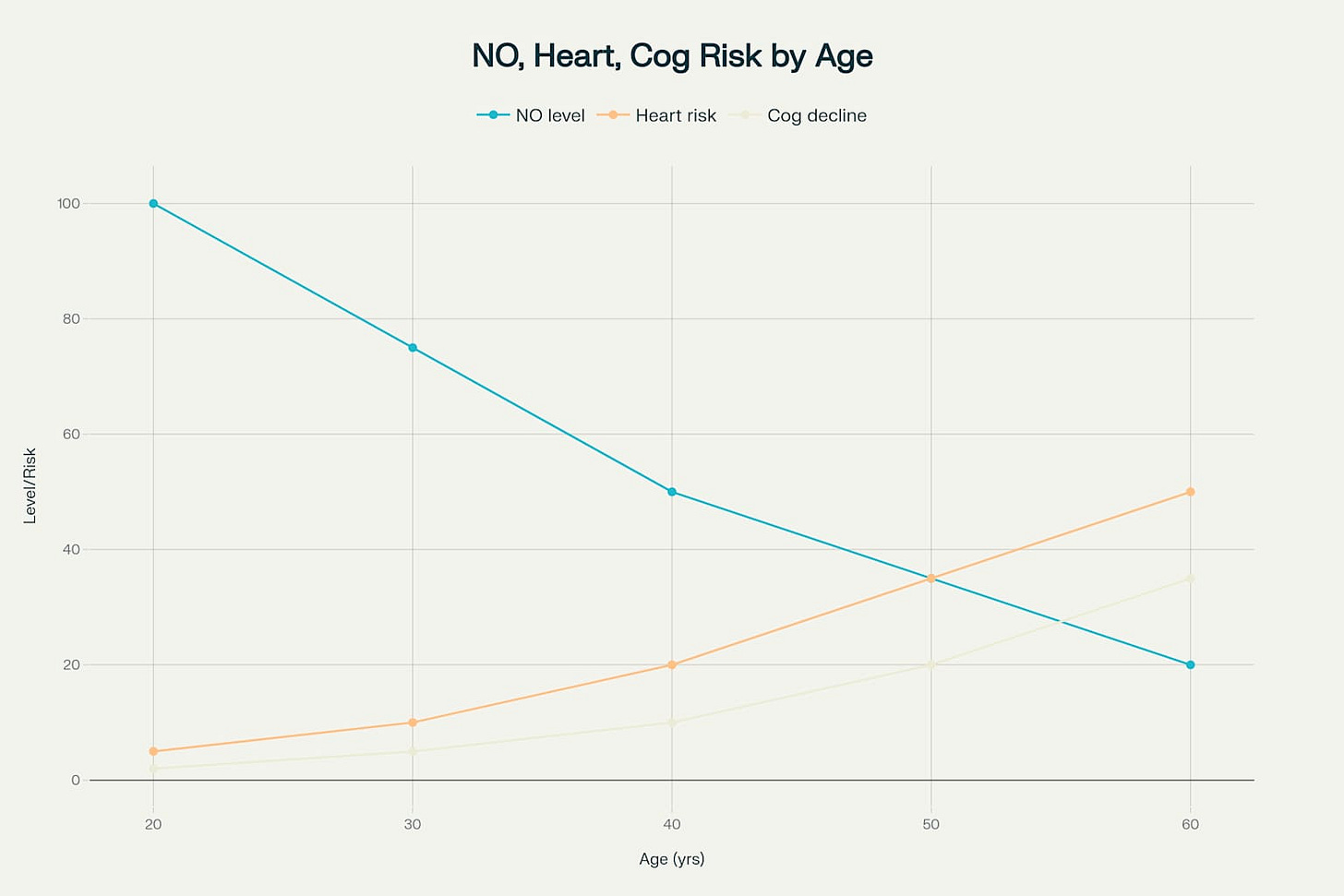Nitric Oxide: Your Secret Weapon for a Longer, Healthier Life
Feeling tired, foggy, or aging fast? Learn how nitric oxide affects brain, heart, and energy—and 5 easy ways to boost it naturally after 40.
Hey there, health seeker!
I’ve been diving into the science of living healthier, and I’ve uncovered a key discovery: nitric oxide (NO). It’s not a trendy supplement or superfood. It’s a molecule your body makes every day. But here’s the problem: by age 40, your NO levels can drop by half. That’s a big deal. Why? NO is like the traffic controller for your blood vessels, brain, and energy systems. When your NO levels are low, you may experience fatigue, brain fog, and serious health issues such as high blood pressure or Alzheimer's disease.
This newsletter focuses on fostering a vibrant life. I’ll break down the science, share easy ways to boost NO, and explain why this is for you and the world. Are you prepared to unleash the potential of NO? Now, let's dive in.
Why Nitric Oxide Matters
You might be thinking, “A molecule? Really?” Hear me out. Nitric oxide is your body’s unsung hero. It keeps your blood vessels flexible, delivering oxygen to your brain, heart, and muscles. It powers your cells’ energy factories (mitochondria, the powerhouses inside your cells). It also supports neuroplasticity; your brain’s ability to learn and adapt. When NO levels drop, things go wrong: stiff blood vessels, low energy, and higher risks of chronic diseases. Research shows over 50% of stubborn high blood pressure cases are linked to NO deficiency, and it’s a key factor in Alzheimer’s risk.
The science goes back decades. In 1998, researchers Robert Furchgott, Louis Ignarro, and Ferid Murad won a Nobel Prize for discovering NO’s role in heart health. But here’s the wild part: most doctors don’t talk about it. Now that you see why NO matters, let’s explore what happens when it’s low.
The Problem: NO Declines with Age
Imagine your body as a busy highway. Nitric oxide is the signal keeping traffic—oxygen and nutrients flowing smoothly. By your 40s, that signal weakens, causing traffic jams. Studies show NO production can decline by 50% as you age isn’t just about feeling exhausted. Low NO is linked to heart disease, diabetes, erectile dysfunction, and cognitive decline. For example, without enough NO, your blood vessels can’t relax, leading to high blood pressure that pills often can’t fix. In the brain, low NO reduces oxygen and glucose, speeding up memory loss or Alzheimer’s. Hospitals use NO to save oxygen-deprived patients.
I felt 40. I felt sluggish, forgot small things, and did not feel like myself. Then I learned about NO, started eating beets, and added L-citrulline supplements. Within weeks, I had more energy and sharper focus during meetings like I’d turned back the clock. My neighbour, 48, had a similar story. He started eating beets daily and switched to nasal breathing. Three months later, his doctor lowered his meds, and he’s hiking with his kids again.
How to Boost NO Naturally
Now that you know the stakes, here’s how to fight back. You don’t need a prescription to boost NO. I’ve tried these strategies, and they’re easier than you think. Here are five ways to start:
Eat Nitrate-Rich Foods: Beets, arugula, spinach, and pomegranate are packed with nitrates, which your body turns into NO. A study found beets lower blood pressure by 5-10 mmHg in weeks. Try this: blend a beet smoothie (beets, spinach, apple) for breakfast or add arugula to your lunch salad.
Breathe Through Your Nose: production in your sinuses. Nasal breathing is a free boost. I switched to nasal breathing on walks, and my energy spiked.
Move Your Body: Weight training or brisk walking ramps up NO by increasing blood flow. A 12-week study showed a 20% NO increase with regular exercise. Aim for 30 minutes, five days a week—think squats or a fast walk.
Soak Up Sunlight: Sunlight triggers NO release in your skin. Get 15-20 minutes daily (adjust for skin type). I take lunch breaks outside, and it lifts my mood too.
Ditch NO Killers: Mouthwash, fluoride toothpaste, and excess sugar destroy oral bacteria needed for NO conversion. Switch to baking soda-based toothpaste.
Sample NO-Boosting Menu
Breakfast: Beet smoothie (1 beet, 1 cup spinach, 1 apple, water).
Lunch: Arugula salad with grilled chicken and pomegranate seeds.
Snack: Handful of walnuts (supports heart health).
Dinner: Baked salmon with steamed spinach.
Supplements: The Extra Push
Aging slows NO production, so supplements can help. L-arginine turns into NO, while L-citrulline recycles into L-arginine for lasting effects. Studies show L-citrulline improves blood vessel function in adults over 40. One of my friend, 52yrs, saw her blood pressure drop after two months of taking 3g of L-arginine daily. I take 5g of L-citrulline daily, which has significantly improved my focus and gym stamina. Start with 3-6g of L-arginine or 5-6g of L-citrulline daily, but check with your doctor, especially if you’re on meds.
Your Brain’s Best Friend
Your brain uses 20% of your body’s oxygen, and NO ensures it gets enough. It improves memory, focus, and neuroplasticity—your brain’s ability to adapt. NO also fights inflammation and plaque buildup, key Alzheimer’s triggers. A study found NO supplements boosted cognitive performance by 15% in older adults. one of my friend dad, 65 yrs, started eating spinach and taking L-citrulline. He’s remembering names better and feels sharper in conversations. Whether you’re 30 and want to stay sharp or 60 and worried about memory, NO is your ally.
NO and Diabetes: Another Win
Beyond heart and brain health, NO helps manage diabetes. It improves insulin sensitivity and blood flow to tissues, reducing complications. A 2020 study found nitrate-rich diets lowered fasting glucose by 10% in diabetic patients. Incorporating beets or spinach into meals can help support blood sugar control, making nitric oxide a versatile tool.
Why is this for everyone?
We’re all aging, and the world’s getting older too. By 2050, people over 65 will hit 2.1 billion, straining healthcare systems. NO tackles root causes of diseases like hypertension and Alzheimer’s, which affect millions. Over 50% of hypertension cases are linked to NO deficiency, and meds often miss the mark [1]. By boosting NO, we can cut healthcare costs and help people live vibrantly into their 80s. Imagine fewer Alzheimer’s cases and preventable heart disease. That’s NO’s potential.
What’s Next?
Nitric oxide isn’t a fad—it’s a fundamental. Start small: add beets to your smoothie, take a sunny walk, or try nasal breathing. These changes add up. Scientists like Dr. Nathan Bryan, who’s studied NO for 25 years, see it as the future of preventive care. In the future, NO-based therapies may reduce the need for pills and increase accessibility to health care.
What’s your first move to live longer and healthier? Drop a comment or reply—I’d love to hear!
This news letter is educational and not medical advice. Always consult a licensed healthcare provider before starting
You can follow my work or get in touch at @levelupnow








